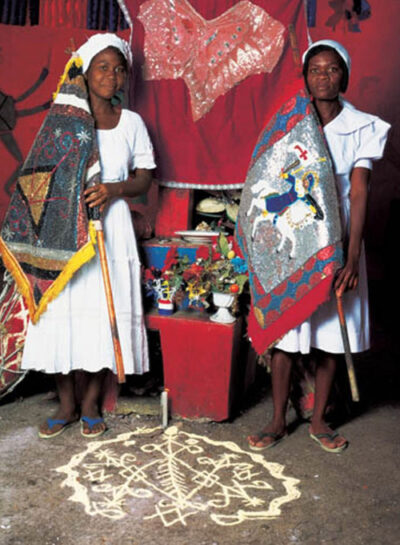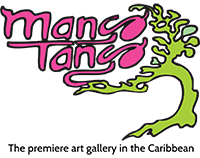Haitian Spirit Art Show
The extreme poverty of Haiti is matched only by the country’s plethora of creativity as shown in this Haitian Spirit Art Show. Most of the artisans have been unaffected by European cultural interest and have retained their African spiritual vision. For the last twenty years Mango Tango Art Gallery has showcased intuitive Haitian paintings.
Steel Drum Art
We now have a brand new arrival of Haitian sculpture made from recycled drums. Old metal drums, once used for transporting oil and other petrol-chemical products, are salvaged by sculptors. The finished works are wall hangings and table top sculptures.
To prepare a drum, the artist cuts out the ends which are used for smaller sculptures. A vertical slit is then scored along the length of the cylinder with both a hammer and a chisel. The drum is then stuffed with paper and straw and set on fire to burn off any residual paints and chemicals. When the drum cools down it is ready to be flattened. The artist climbs onto the body of the drum and uses all his weight and strength to open it up. The leveled drum becomes a rectangular sheet around four by six foot wide.
The whole sheet of metal is then hammered to make the metal softer and easier to cut. Any surplus charred oil, paint or rust is rubbed off before the artist draws his designs on the metal sheet using a piece of chalk. The figure or design is cut out with a hammer and a chisel. The finished sculpture is signed by the artist and coated with a film of varnish.
The artists’ ingenuity and quality of imagination, combined with elements of voodoo and surrealism, and their refined metalworking technique have captured the attention of collectors world wide. These works of art will gain more value in time, now that the modern 55 gallon drum is made of plastic. As the steel drum disappears from the scene, the art of steel drum sculpture will become increasingly rare.
The unique and striking relief sculptures are inspired by the rich mythology of Vodou, which was developed in Haiti by slaves first brought from Africa in the sixteenth century. The mermaid depicts La Siren, the sea spirit. The bull represents Bosou, the master of agriculture, while the snake is the symbolic image of Dambala, the most powerful spirit who can bring, luck and happiness.
Paintings
Paintings from Haiti have been delighting collectors since the 1950”s. The grouping at Mango Tango are quite varied in theme. They include florals, fantasy, portraits, island life, and spiritual depictions. Many of the artists included in this show have exhibited in the United States and Europe and have permanent displays in museums.
Voudou Flags
The religious origins of Voudou flags are sometimes overshadowed by their increasing popularity as pure objects of art by collectors.
These flags, made from satin, silk, cloth or burlap, and embroidered with beads, pearls, and sequins of often radiantly iridescent colors, are today much sought-after for their aesthetics. The colorful embroidery, the complexity of the decorative patterns, the sheer inventiveness in the depiction of the various loas to whom the flags are dedicated, are certainly captivating.
In the past, however, Voudou flags have been regarded as sacred and they play an important part in Voudou ceremonies. Stored in shrines, these sacred objects are carried out during ceremonies by Voudou priestesses, to honor and call forth the “loas” or spirits to whom the ceremony is dedicated. Formerly, Voudou flags were designed by Voudou priests. Antique flags are often, but not always, starker in color and design, their patterns less intricate, their embroidery less complex.
A large flag often contains 18,000 to 20,000 sequins and takes about 2 weeks to complete. A rod is placed through the channel at the top of the flag, allowing the practitioner to wave the shimmering fabric, hoping to please the “loa” and gain favor. Jane Coombes notes that the flags are waved during ceremonies, but we have framed them under glass to both protect and display them as an artifacts.
Today, a growing number of artists, as well as Voudou priests, continue to design and make these flags.

Copyright: Phyllis Galembo
